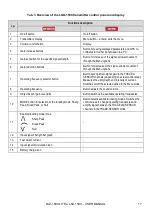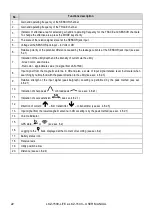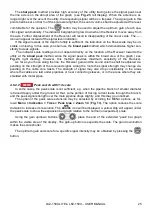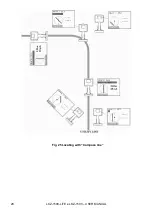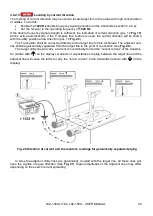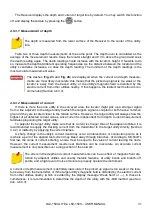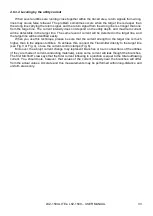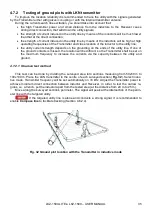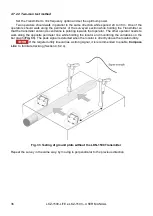
LKZ-1500-
LITE ● LKZ-1500 – USER MANUAL
31
The Receiver displays the depth and current of target line by default. You may switch this function
off, and display these data by pressing the
button.
4.6.3.1 Measurement of depth
The depth is measured from the lower surface of the Receiver to the center of the utility
line.
Take two or three depth measurements at the same point. The depth level is calculated as the
average of the measurement results. Keep the locator straight and 0.3 m above the ground and seek
the depth reading again.
The depth reading should increase with the locator’s height. If feasible to do
so, measure the depth at different operating frequencies. As the distance between the locator and the
utility’s centreline increases, so does the depth reading. The minimum of the depth readings is the
most accurate measurement value.
The dashes (
) are displayed when the current and depth measure-
ments are most likely inaccurate; this means that the picked up signal is too weak or the
locator is away from the traced utility, or the utility’s magnetic field is distorted by the
electric current from other utilities nearby. If this happens, the indirect test method is rec-
ommended (Section 4.6.3.3).
4.6.3.2 Measurement of current
If there is more than one utility in the surveyed area, the locator might pick up a stronger signal
from a line adjacent to the target utility to which the target’s signal is coupled or both have a common
ground if they are located closer to the terrain surface. However, the target utility will always show the
highest of all detected current values, since current is independent from depth. Current measurement
facilitates pinpointing the target utility.
To pinpoint the target utility, make sure that its current is stronger than of the adjacent utilities. It is
recommended to supply the tracking current from the transmitter to the target utility directly (Section
3.4.2) or indirectly by applying the current clamps.
A sharp change in the utility’s current trend may occur at intersections or connection points, as it
is where a part of the applied test current may bleed away through branches. According to Kirchhoff’s
first law, the value of current entering a node must be equal to the value of current leaving the node.
However, the current measurement results near branches can be inaccurate. An accurate current
measurement is only possible over a long section of the network.
The errors in the depth and current measurements can be an effect of magnetic field dis-
tortion by adjacent utilities and nearby metallic features, at utility bends and branch-off
points, and a high level of noise or failure to properly operate the instrument.
A current or depth measurement is definitely inaccurate if the picked up signal is too weak or the loca-
tor is a
way from the transmitter, or if the target utility’s magnetic field is distorted by the electric current
from other utilities nearby (which is evident by the display message “Weak field” or ---). In these cir-
cumstances, it is recommended to determine the depth of the utility with the -6dB method (see Sec-
tion. 4.6.3.3).
Summary of Contents for LKZ-1500
Page 1: ......
Page 2: ......
Page 18: ...LKZ 1500 LITE LKZ 1500 USER MANUAL 16 Fig 10 LKO 1500 receiver panel...
Page 30: ...LKZ 1500 LITE LKZ 1500 USER MANUAL 28 Fig 25 Locating with Compass line...
Page 57: ...LKZ 1500 LITE LKZ 1500 USER MANUAL 55 NOTES...
Page 58: ...LKZ 1500 LITE LKZ 1500 USER MANUAL 56 NOTES...
Page 59: ......
Page 60: ......

